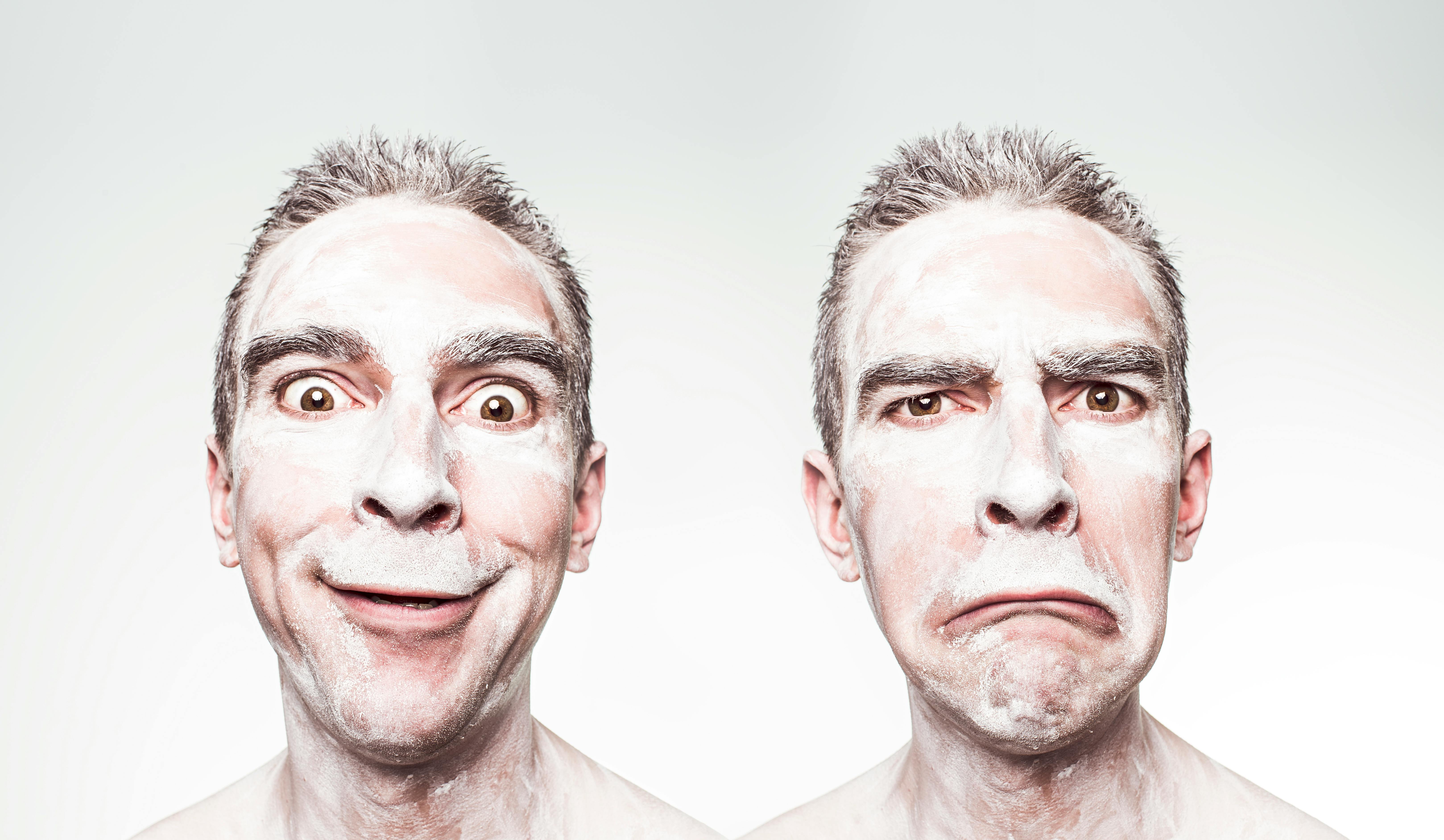Bad day? How it can seem even worse for some
Many people do not realize how often our emotions affect us. Our emotions dictate what things we focus on or attend to, how we interpret things, and what things we think of or memories we recall. This article aims to describe how emotion processing biases occur in our lives.
The positive and negative events we experience during the day set the tone for the remainder of the day. In our daily activities, if we are in a good mood, we might think back at our day going well, but if we are cranky or irritated, we might think our day was awful. Everyone experiences emotions on some level, which help us understand and respond to the world around us. Emotions can be helpful, such as fear elicited from sighting a bear prompting us to run to avoid being mauled or anxiety helping us to finish that project so we don’t get fired. However, evidence suggests that there is a “middle-man” working behind the scenes between us having an emotion and us interacting with the surrounding world. The idea is that we have an emotion processing bias that alters the way our emotions affect us. Although this bias can be either negative or positive, within the context of this article we will be focusing predominantly on the negative aspect. Nevertheless, there are ways that we can limit its effect to potentially improve our day.
For instance, Andrew typically wakes up every morning promptly at 7 a.m., gets ready, and heads to work. On this particular day during his commute to work, he receives a call from his bank informing him that they will not be giving him a loan he needs in order to purchase a new house. Naturally, receiving information like this would ruin anyone’s day. However, some people, like Andrew, are more likely to hold onto negative events, internalize them, and have them affect their emotion processing. He begins to worry about how he and his family will be able to find a new home with their current home already on the market and then internalizes the rejection, thinking of himself as an unsuccessful provider for his family.
Because Andrew internalizes and holds on to this rejection, it continues to affect him throughout the day. When Andrew arrives at work and his boss asks to see him in her office, he still has the phone call on his mind, causing him to be more negatively biased. This leads to Andrew thinking that his boss wants to see him due to something he did wrong. Although his boss may simply want to ask him a routine question or give him praise for doing something well, his experience with the bank is influencing his thinking to be negatively biased and he is having difficulty seeing a neutral or potentially positive situation as anything but negative.
Some of us may think Andrew’s reaction is drastic; in reality, it is not uncommon for someone to respond negatively to seemingly neutral social situations, especially if they have recently experienced a negative situation. So, do people become emotionally biased or are they typically negative? It can be a combination of both, but psychologists have found certain reasons why negative emotion processing biases occur more with some individuals than others.
Emotion Processing Bias
Emotion processing bias refers to the way we process information from our environment in a way that corresponds with our emotional state. There are three factors that make up emotion processing bias: Attention bias, Memory bias, and Interpretation bias. A well-replicated study investigating attention bias asked participants to view a series of faces that were threatening, neutral, or happy and to identify the type of face as quickly as possible (Bradley, Mogg, White, Groom, & de Bono, 1999). Bradley and colleagues (1999) discovered that people with higher levels of anxiety were not only more vigilant at identifying threatening images of faces, but they were also quicker to identify all emotional faces in general. This shows how we can become more focused on certain social cues, like faces, and how they are related to emotion. In Andrew’s case, he attended to his boss’s facial expression when she asked to speak with him and attributed the frown on her face was related to his work performance.
Memory bias occurs when we recall more unpleasant information or memories than pleasant ones, when we are not in a good mood (e.g. feeling depressed or anxious). The opposite is also true, meaning we recall more pleasant memories during good mood state. This, however, is not always a hard and fast rule. Watkins (2002) reviewed findings on the effects of mood on memory, particularly that of depression. Depression often involves rumination, or preoccupation, on negative events one has experienced, which can impact how a person recalls a variety of information. More specifically, conceptual processing, or ruminating on a memory, leads one to recall information congruent with the mood associated with the rumination. Watkins labels this as mood-congruent memory (MCM; see Watkins, 2002). In a study invin a way estigating MCM, depressed and non-depressed individuals were presented with lists of depression-related words (e.g., “hopeless,” “guilty”), as well as positive, neutral, or threat-related words (Watkins, Mathews, Williamson, & Fuller, 1992). Participants were asked to imagine themselves in a scenario involving each word, then later had to recall the words with the help of cues (i.e., certain letters of words given “p_acf_l” for peaceful). The authors found that depressed individuals recalled more depression-related words than any other category, as well as more depression-related words than the non-depressed individuals recalled (1992). So, if we’re feeling agitated like Andrew, we may be more likely to recall upsetting times in our life and these recollections will shape what new information we remember. But is this the reason why Andrew was having a bad day, or could it be attributed to something else as well?
Interpretation bias happens when ambiguous information or stimuli is construed as threatening or negative. It has been shown that people who are feeling depressed, highly anxious, or who have some social phobias are more likely to process information in a biased fashion. In a study conducted by Vassilopoulos (2006), the author had socially anxious and non-anxious college students respond about how they would react in negative and positive social events, such as not being invited to a party or being applauded after giving a speech. One item asked, “How would you feel if your friends had a party and didn’t invite you?” The author found that participants who were more socially anxious were more likely to evaluate a negative event or situation as worse than it actually is, which in turn makes them more likely to avoid possibly negative situations in the future. Even when presented with a positive social situation, they still evaluate it as less positive than non-socially anxious individuals. So, what could this mean for the general population? Well, if you are feeling anxious or depressed, you may not be fully aware of the positive situations unfolding around you; you may only see the glass as half empty like Andrew.
When Bad Thinking Goes Beyond Bad Thoughts
People often believe that if they aren’t diagnosed with a mental health disorder then they are safe from the consequences that come along with mental health illness. This could not be farther from the truth. Almost everyone experiences symptoms of a mental disorder on occasion when life events occur. For example, if you have a big presentation to give at work, then feeling anxious is normal. The same can be said with feeling depressive symptoms after ending a relationship. These types of emotions occur for everyone at some level, meaning that without realizing it, most people are likely experiencing emotion processing biases, simply because life happens and it affects our mood. The important thing to consider here is that emotion processing biases can be worsened by depressive or anxious feelings.
Effects of Depressive Symptoms
There’s a wide array of research on depression and depressive symptoms. Researchers agree that depressive symptoms negatively affect people as shown by how they perceive the world around them and their daily activities. This negative perception is emotion processing bias and occurs in the forms of attention bias, memory bias, and interpretation bias. Now, imagine a day where something bad happened that made you feel really sad. Were you more likely to watch funny videos and listen to upbeat, happy music, or did you listen to sad music and feel no interest in anything happy? The work of Lee, Andrade, and Palmer (2013) has shown that we’re more likely to select sad music and to avoid happy or cheerful things. The reason behind this was studied by Romens and Pollak (2012), who found that even people who are at risk for depression are more likely to have an attention bias because they will focus on sad cues, such as sad music. As mentioned before, sad and depressed individuals are more likely to remember mood-congruent (sad → sad, happy → happy) memories, and because people who are feeling sad or depressed are more likely to focus on sad situations or stimuli, they typically end up feeling more depressed, causing a negative cycle (Linden, Jackson, Subramanian, Healy, & Linden, 2011). If you are having a bad day, do you think you will focus on all of the friends you have and how they support you, or would you focus more on the people who have let you down or hurt you? Even if you do think of the supportive people in your life, they may not seem as supportive as they would if you were not feeling sad or depressed. This may be due to the fact that you are negatively biased at that moment to interpret things as more negative, causing you to react more to the negative events, faces, emotions, and expressions of others, as well as to see things as more negative than they are. (Rohrbacker & Reinecke, 2014).
Effects of Anxiety and Social- Anxiety Symptoms
Similar to depression, just because you are not diagnosed with an anxiety disorder does not mean you never experience anxiety. For example, if you had to give a speech in front of a large audience, you probably would experience symptoms of anxiety, including sweating, dizziness, or fear of rejection or criticism. These feelings of anxiety can affect how we perceive the world around us, especially our social interactions. This is not to say that all negative emotions are bad; they are often very helpful and meant to protect us. For example, if we are feeling anxious, we are more attuned to threatening situations. When walking alone at night in a strange neighborhood, our anxiety could protect us from a potential threat (MacLeod, Matthews, & Tata, 1986). Additionally, we are more likely to remember threatening situations than non-threatening situations when we are feeling anxious (Mathews, Mogg, May, & Eysenk, 1989). Take Andrew for example: if his boss had put him on probation or threatened to fire him on a previous occasion, he might be primed to think of that when she called him into his office, heightening his feelings of anxiety. When we put ourselves into anxiety-provoking situations, we really are more reactive to the social situation that is causing the anxiety, causing us to feel more emotionally biased, which only ends up making us feel more anxious. So what can be done to stop the cycle?
How to Stop the Cycle
Many studies seek to target what is causing these emotion processing biases and how we can reduce them. In an attention bias modification study, McNally, Enock, Tsai, & Tousian (2013) found that practice really does make perfect. They recognized that if you are feeling anxious about something, such as giving a speech, practicing it four or more times in front of a smaller group of people will actually reduce your anxiety once you have to give the speech to a large audience. Other researchers have looked into ways to decrease the effects of interpretation biases and found that if you have an improved ability to manage stress and difficult social situations, you are less likely to experience interpretation biases (Kleim, Thörn, & Ehlert 2014; Menne-Lothmann et al. 2014). Bringing it back to our example with Andrew, if, after finding out that he didn’t get the loan approved, he took a few deep breaths, giving himself time to process the information, or employing stress reducing techniques like muscle relaxation, then he might have been able to approach the meeting with his boss in a more impartial way.
Treatments have also been developed that target getting people out of the “negative emotion cycle,” such as Acceptance and Commitment Therapy (ACT; Hayes, Luoma, Bond, Masuda, & Lillis, 2006). This therapeutic treatment and others like it have a strong focus on present-focused awareness, which in the simplest terms means keeping your thoughts on the present. The idea behind ACT is not to try to get rid of the bad feelings or suppress them, but to change the areas of your life that you can and accept the areas that you can’t (see Harris [2008] for a better guide to working on your emotions).
Conclusion
Although we as humans are prone to misperceptions in the way we see the world, we have identified several mechanisms that may contribute to this phenomenon and introduced some steps that might help counteract it. The discussion explained how our attention, memory, and interpretation biases all affect how we process our emotions. We are primed by these biases to view neutral stimuli in a certain way based on current emotions and past experiences. Given enough past learning experiences, along with temperament, these biased views of the world can potentially manifest into psychological issues. Fortunately, there are treatments available to reduce these issues by improving our emotional processing and managing our biases. We can overcome the impact certain uncontrollable events have on our mood, breaking the cycle in which misperceptions may have once locked us. Andrew, realizing that he didn’t get the home loan, could utilize these skills to recognize his emotion-bound biases so that he doesn’t let his feeling of worry and anxiety overcome him and affect his work.
References
Bradley, B. P., Mogg, K., White, J., Groom, C., & de Bono, J. (1999). Attentional bias for emotional faces in generalized anxiety disorder. The British Journal of Clinical Psychology / the British Psychological Society, 38 ( Pt 3)(3), 267-278.
Harris, R. (2008). The Happiness Trap: How to stop struggling and start living. Boston, MA: Trumpeter.
Hayes, S. C., Luoma, J., Bond, F., Masuda, A., & Lillis, J. (2006). Acceptance and commitment therapy: Model, processes and outcomes.10.1016/j.brat.2005.06.006
Kleim, B., Thörn, H. A., & Ehlert, U. (2014). Positive interpretation bias predicts well-being in medical interns. Frontiers in Psychology, 5, 640. doi:10.3389/fpsyg.2014.00640
Lee, C. J., Andrade, E. B., & Palmer, S. E. (2013). Interpersonal Relationships and Preferences for Mood-Congruency in Aesthetic Experiences. Journal Of Consumer Research, 40(2), 382-391. doi:10.1086/670609
Linden, S. C., Jackson, M. C., Subramanian, L., Healy, D., & Linden, D. E. J. (2011). Sad benefit in face working memory: An emotional bias of melancholic depression. Journal of Affective Disorders, 135(1-3), 251-257. doi:10.1016/j.jad.2011.08.002
MacLeod, C., Mathews, A., & Tata, P. (1986). Attentional bias in emotional disorders. Journal of Abnormal Psychology, 95(1), 15-20. doi:10.1037/0021-843X.95.1.15
Mathews, A., Mogg, K., May, J., & Eysenck, M. (1989). Implicit and explicit memory bias in anxiety. Journal of Abnormal Psychology, 98(3), 236-240. doi:10.1037/0021-843X.98.3.236
McNally, R. J., Enock, P. M., Tsai, C., & Tousian, M. (2013). Attention bias modification for reducing speech anxiety. Behaviour Research and Therapy, 51(12), 882-888. doi:10.1016/j.brat.2013.10.001
Menne-Lothmann, C., Viechtbauer, W., Höhn, P., Kasanova, Z., Haller, S. P., Drukker, M., & ... Lau, J. F. (2014). How to Boost Positive Interpretations? A Meta-Analysis of the Effectiveness of Cognitive Bias Modification for Interpretation. Plos ONE, 9(6), 1-26. doi:10.1371/journal.pone.0100925
Rohrbacher, H., & Reinecke, A. (2014). Measuring change in depression-related interpretation bias: Development and validation of a parallel ambiguous scenarios test. Cognitive Behaviour Therapy, 43(3), 239-250. doi:10.1080/16506073.2014.919605
Romens, S. E., & Pollak, S. D. (2012). Emotion regulation predicts attention bias in maltreated children at-risk for depression. Journal of Child Psychology and Psychiatry, and Allied Disciplines, 53(2), 120-127. doi:10.1111/j.1469-7610.2011.02474.x
Vassilopoulos, S. P. (2006). Interpretation and judgmental biases in socially anxious and nonanxious individuals. Behavioural and Cognitive Psychotherapy, 34(2), 243-254. doi:10.1017/S1352465805002687
Watkins, P. (2002). Implicit memory bias in depression. COGNITION & EMOTION, 16(3), 381-402. doi:10.1080/02699930143000536
Watkins, P. C., Mathews, A., Williamson, D. A., & Fuller, R. D. (1992). Mood-congruent memory in depression: Emotional priming or elaboration?. Journal Of Abnormal Psychology, 101(3), 581-586. doi:10.1037/0021-843X.101.3.581



